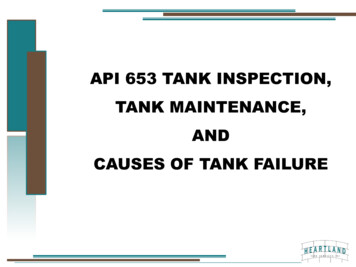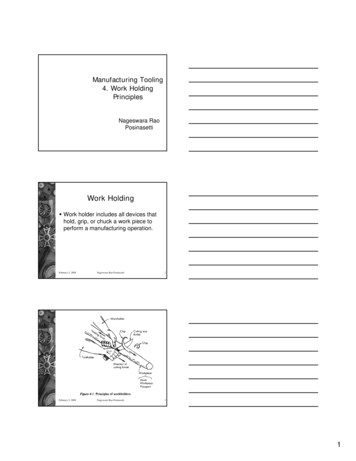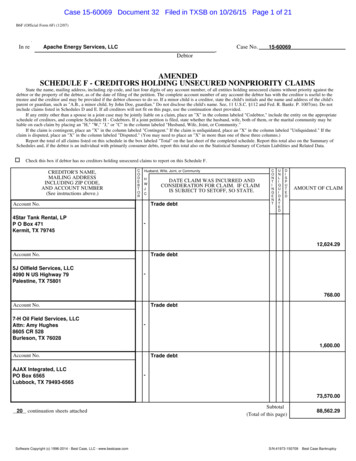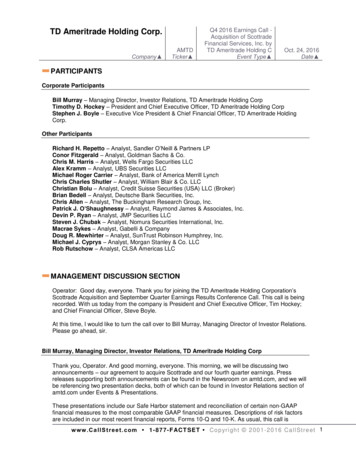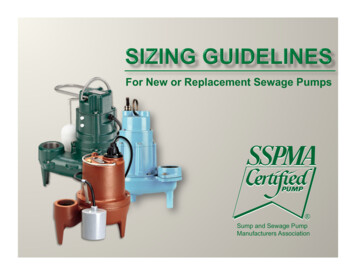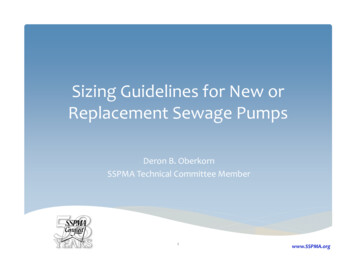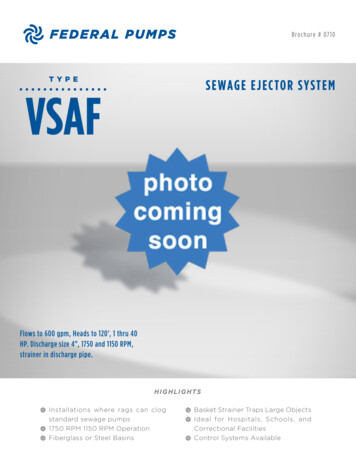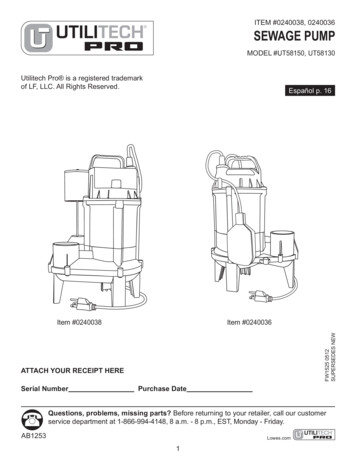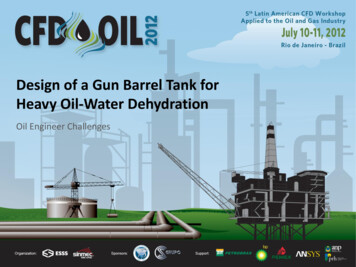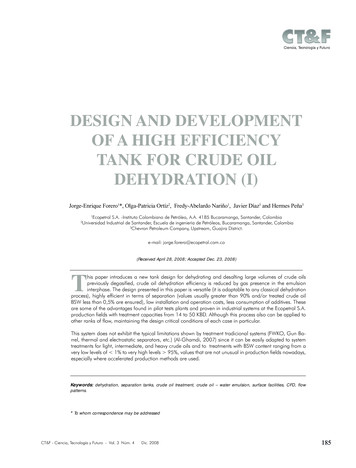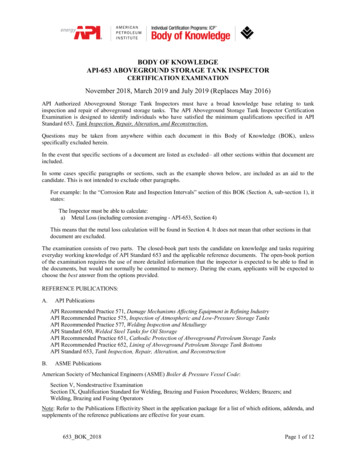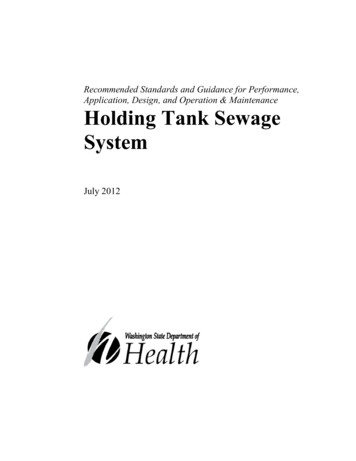
Transcription
Recommended Standards and Guidance for Performance,Application, Design, and Operation & MaintenanceHolding Tank SewageSystemJuly 2012
Recommended Standards and Guidance forPerformance, Application, Design, and Operation & MaintenanceHolding Tank Sewage SystemsJuly 2012For information or additional copies of this report contact:Wastewater Management SectionPhysical address: 243 Israel Road SE, Tumwater, WA 98501Mailing address: PO Box 47824, Olympia, WA h.wa.govJohn WiesmanSecretary of HealthTo request this document in another format, call 1-800-525-0127. Deaf or hard of hearingcustomers, please call 711 (Washington Relay) or email civil.rights@doh.wa.gov.Para solicitar este documento en otro formato, llame al 1-800-525-0127. Clientessordos o con problemas de audición, favor de llamar al 711 (servicio de relé deWashington) o enviar un correo electrónico a civil.rights@doh.wa.gov.DOH 337-006
Holding Tank Sewage Systems - Recommended Standards and GuidanceEffective Date: July 1, 2012Contents . PagePreface .4Introduction .61.Performance Standards .72.Application Standards ng .8Installation.9Inspection .9Design Standards .9Tank Design / Material Requirements .9Sizing .10Design Considerations .10Alarms .12Piping .13Venting and Odor Control .13Overflow Provisions .14Surface Water.14Materials .14Operation and Maintenance .14Pumping and Service .14Pumping Service Contracts .15Operational Permit .15Disposal of Contents .16Large On-Site Sewage Systems .16Requirements for Large On-Site Sewage Systems .16Requirements for Large On-Site Holding Tank Sewage Systems .17Figure 1: Longitudinal-Section of Typical Holding Tank System .6Table 1: Minimum Horizontal Separations .8Glossary of Terms: A glossary of common terms for all RS&Gs can be found on the DOH Website at f.DOH 337-006Page 3 of 17
Holding Tank Sewage Systems - Recommended Standards and GuidanceEffective Date: July 1, 2012PrefaceThe recommended standards contained in this document have been developed for statewideapplication. Regional differences may, however, result in application of this technology in amanner different than it is presented here. In some localities, greater allowances than thosedescribed here may reasonably be granted. In other localities, allowances that are provided for inthis document may be restricted. In either setting, the local health officer has full authority in theapplication of this technology, consistent with Chapter 246-272A WAC and local jurisdictionalrules. If any provision of these recommended standards is inconsistent with local jurisdictionalrules, regulations, ordinances, policies, procedures, or practices, the local standards takeprecedence. Application of the recommended standards presented here is at the full discretion ofthe local health officer.Local jurisdictional application of these recommended standards may be:1) Adopted as part of local rules, regulations or ordinances—When the recommendedstandards, either as they are written or modified to more accurately reflect local conditions,are adopted as part of the local rules, their application is governed by local rule authority.2) Referred to as technical guidance in the application of the technology—Therecommended standards, either as they are written or modified to more accurately reflectlocal conditions, may be used locally as technical guidance.Application of these recommended standards may occur in a manner that combines these twoapproaches. How these recommended standards are applied at the local jurisdictional levelremains at the discretion of the local health officer and the local board of health.The recommended standards presented here are provided in typical rule language to assist thoselocal jurisdictions where adoption in local rules is the preferred option. Other information andguidance is presented in text boxes with a modified font style to easily distinguish it from therecommended standards.Glossary of Terms: A glossary of common terms for all RS&Gs can be found on the DOH Website at -028.pdf.The recommended standards contained in this document have been primarily written to supportthe design of on-site sewage systems with design flows less than 3500 gpd, but may also beapplied to large on-site sewage systems (LOSS).With the adoption of the revised LOSS rule, chapter 246-272B WAC, in 2011, some provisions ofthe RS&Gs may not be appropriate or allowed for LOSS. Many applicable requirements from theRS&Gs have already been included in the LOSS rule. Design engineers and others interested inLOSS are directed to consult the rule and LOSS program staff before or instead of the RS&Gs.DOH 337-006Page 4 of 17
Holding Tank Sewage Systems - Recommended Standards and GuidanceEffective Date: July 1, 2012Typical RS&G Organization:Standards SectionPerformanceExplanationApplicationHow this technology is to be applied. Thissection includes conditions that must be metprior to proceeding with design. Topics inthis section describe the “approved” status ofthe technology, component listingrequirements, permitting, installation, testingand inspection requirements, etc.DesignHow this technology is to be designed andconstructed (includes minimum standards thatmust be met to obtain a permit).Operation and MaintenanceHow this technology is to be operated andmaintained (includes responsibilities ofvarious parties, recommended maintenancetasks and frequency, assurance measures, etc)AppendicesDesign examples, figures and tables, specificapplications, and design and installationissues.DOH 337-006How this technology is expected to perform(treatment level and function)Page 5 of 17
Holding Tank Sewage Systems - Recommended Standards and GuidanceEffective Date: July 1, 2012IntroductionA Holding Tank Sewage System (HTSS) is an alternative to a conventional on-site sewagesystem with very special and limited applications. Simply, the HTSS provides a means to collectand temporarily store sewage from a facility or dwelling, for subsequent removal and transport toan approved treatment and disposal site. Depending upon the facility served or the particular setof circumstances surrounding the use of a HTSS, the expense of sewage pumping, hauling, anddisposal at an approved facility can be very costly, especially on a long-term basis. In addition,the potential for operational/management problems with resulting public exposure to raw sewageis significant. For this reason, use of a HTSS must be closely regulated by the local healthagency.A HTSS is an on-site sewage system that incorporates a holding tank, the services of a sewagepumper/hauler, and the off-site treatment and disposal of the sewage generated at the site servedby the HTSS.Figure 1. Longitudinal-Section of Typical Holding Tank Sewage System.Access Riser with securedgas tight lidInletfromstructureInletpipeWarning Light andAudible AlarmPumping Access Port withsloped concrete padReserve Storage VolumeNormal Operating VolumeDOH 337-006Page 6 of 17
Holding Tank Sewage Systems - Recommended Standards and GuidanceEffective Date: July 1, 20121. Performance StandardsHolding Tank Sewage Systems must provide safe and adequate temporary storage of sewage,with scheduled and approved pumping service followed by approved off-site treatment anddisposal of the stored sewage. By design, installation, and operation and maintenance HTSSmust not contaminate ground or surface waters, expose the public to untreated sewage or be asource of nuisance odors.2. Application Standards2.1. PermittingBefore installing and using a HTSS, a permit that addresses installation, operation andmaintenance must be obtained from the local health agency. The permit should includespecific information and requirements for pumping service frequency and approveddisposal of holding tank contents. The local health officer may permit Holding TankSewage Systems only in the following cases:2.1.1. Emergency Use - Emergency situations, regardless of source of the sewage, eithercommercial or residential. Emergency situations are limited to those where anapproved repair or replacement sewage system installation is delayed due toweather conditions, and/or weather-induced soil or site conditions.2.1.2. Permanent Use2.1.2.1. Controlled, part-time, commercial usage situations, such as recreationalvehicle parks, trailer dump stations, campgrounds, marinas, etc.2.1.2.2. Repair of failing on-site sewage systems - but only where no other option isfeasible. The local health officer must first determine that the followingoptions are not feasible:2.1.2.2.1. Conventional on-site sewage system;2.1.2.2.2. Conventional on-site sewage system with off-site drainfield;2.1.2.2.3. Alternative on-site sewage system with enhanced treatment prior todisposal to the receiving soils;2.1.2.2.4. Connection to a publicly, or privately, owned larger on-site sewagesystem;2.1.2.2.5. Connection to public sewer; or,2.1.2.2.6. Connection of an effluent pump to a public sewer.DOH 337-006Page 7 of 17
Holding Tank Sewage Systems - Recommended Standards and GuidanceEffective Date: July 1, 20122.2. Siting2.2.1. The holding tank portion of the holding tank sewage system must be located insuch a way as to facilitate pumping while limiting the general public exposure to,or nuisance caused by, accidental sewage spillage during pumping.2.2.2. The holding tank sewage system must meet the same horizontal set-backsrequired for sewage tanks by WAC 246-272A-0210, (Location).Table 1 Minimum Horizontal SeparationsItems Requiring SetbackWell or suction linePublic drinking water wellPublic drinking water spring measured from the ordinary highwater markSpring or surface water used as drinking water source measuredfrom the ordinary high water mark1Pressurized water supply lineDecommissioned well (decommissioned in accordance withchapter 173-160 WAC)Surface water measured from the ordinary high water markBuilding foundation / in-ground swimming poolProperty or easement lineInterceptor / curtain drains/ foundation drains / drainage ditchesDown-gradient2:Up-gradient2:Other site features that may allow effluent to surfaceDown-gradient2:Up-gradient2:Down-gradient cuts or banks with at least 5 ft. of original,undisturbed soil above a restrictive layer due to a structural ortextural change.Down-gradient cuts or banks with less than 5 ft. of original,undisturbed, soil above a restrictive layer due to a structural ortextural change.Other adjacent soil dispersal components/subsurface stormwaterinfiltration systemsFrom sewage tankand distribution box50 ft.100 ft.200 ft.50 ft.10 ft.N/A50 ft.5 ft.5 ft.5 ft.N/A5 ft.N/AN/AN/AN/AIf surface water is used as a public
3.2. Sizing . Holding Tank Sewage Systems must provide safe and adequate temporary storage of sewage, with scheduled and approved pumping service followed by approved off-site treatment and disposal of the stored sewage. By design, installation, and operation and maintenance HTSS must not contaminate ground or surface waters, expose the public to untreated sewage or be a source of
